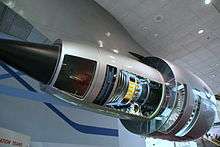Pratt & Whitney JT9D
| JT9D | |
|---|---|
 | |
| The internal structure of the JT9D. | |
| Type | Turbofan |
| Manufacturer | Pratt & Whitney |
| First run | December 1966 |
| Major applications | Boeing 747 Boeing 767 Airbus A310 McDonnell Douglas DC-10 |
| Developed into | Pratt & Whitney PW4000 |
The Pratt & Whitney JT9D engine was the first high bypass ratio jet engine to power a wide-body airliner. Its initial application was the Boeing 747-100, the original "Jumbo Jet". It was the company's first high-bypass-ratio turbofan.[1]
Design and development
The JT9D was developed as part of the design phase of the C-5 Galaxy. A contract was awarded to Pratt & Whitney to study the type of large engine needed, but the production contract was eventually awarded to General Electric and their TF39 turbofan. The JT9D was, however, chosen by Boeing to power the 747, with that aircraft's first flight taking place on 9 February 1969. Flight testing of the engine had begun in June 1968, using a Boeing B-52E as a testbed.
The JT9D-3, which entered service in 1970, was constructed using titanium and nickel alloys. The engine featured a single-stage fan, a three-stage low-pressure compressor and an eleven-stage high-pressure compressor coupled to a two-stage high-pressure turbine and four-stage low-pressure turbine. This version of the JT9D weighed 8,608 lb (3,905 kg) and produced 43,500 lbf (193,000 N) thrust. Production ceased in 1990.
JT9D engines powering USAF E-4A airborne command posts were designated Pratt & Whitney F105.
Pratt & Whitney's designated successor to the JT9D family is the PW4000, which features fewer parts, greater reliability, and lower base selling price.

Applications
Specifications (JT9D-7 series)
Data from [2]
General characteristics
- Type: High bypass two-spool turbofan engine
- Length: 128.2 in (3,260 mm) (less intake ring and nozzle)
- Diameter: 92.3 in (2,340 mm) (Fan tip)
- Dry weight: 8,608 lb (3,905 kg)
Components
- Compressor: 1-stage Fan, 3-stage LP compressor and 11-stage HP compressor
- Combustors: Annular combustion chamber
- Turbine: 2-stage HP turbine and 4-stage LP turbine
- Fuel type: Aviation Kerosene typically Jet A-1
- Oil system: pressure spray with scavenge
Performance
- Maximum thrust: 46,300 to 50,000 lbf (205.95 to 222.41 kN) take-off
- Overall pressure ratio: overall 23.4:1 (Fan 1.64:1)
- Bypass ratio: 5.0:1
- Specific fuel consumption: ca 0.6 lb/lbf/hr (61.16 kg/kN/hr) at M0.8 at 35,000 ft (11,000 m)[3]
- Thrust-to-weight ratio: 5.4 to 5.8
| Model | Static Thrust | Basic Engine Weight | Length | Fan Diameter | Application |
|---|---|---|---|---|---|
| JT9D-3A | 45,800 lbf (203.73 kN) | 8,608 lb (3,905 kg) | 128.2 in (3,260 mm) | 92.3 in (2,340 mm) | Boeing 747-100 |
| JT9D-7 | 47,900 lbf (213.07 kN) | 8,850 lb (4,010 kg) | 128.2 in (3,260 mm) | 92.3 in (2,340 mm) | Boeing 747 |
| JT9D-20 | 49,400 lbf (219.74 kN) | 8,450 lb (3,830 kg) | 128.2 in (3,260 mm) | 92.3 in (2,340 mm) | McDonnell Douglas DC-10/Boeing 747 |
| JT9D-7Q/7Q3 | 53,000 lbf (235.76 kN) | 9,295 lb (4,216 kg) | 132.1 in (3,360 mm) | 93.6 in (2,380 mm) | Boeing 747 |
| JT9D-59A/70A | 53,000 lbf (235.76 kN) | 9,155 lb (4,153 kg) | 132.2 in (3,360 mm) | 93.6 in (2,380 mm) | McDonnell Douglas DC-10/Boeing 747/Airbus A300 |
| JT9D-7R4D/D1 | 48,000 lbf (213.51 kN) | 8,905 lb (4,039 kg) | 132.7 in (3,370 mm) | 93.4 in (2,370 mm) | Boeing 767/Airbus A310 |
| JT9D-7R4G2 | 54,750 lbf (243.54 kN) | 8,935 lb (4,053 kg) | 132.7 in (3,370 mm) | 93.4 in (2,370 mm) | Boeing 747 |
| JT9D-7R4H1 | 56,000 lbf (249.10 kN) | 8,885 lb (4,030 kg) | 132.7 in (3,370 mm) | 93.4 in (2,370 mm) | Airbus A300 |
See also
- Related development
- Comparable engines
- General Electric TF39 (military)/General Electric CF6 (civilian)
- Progress D-18T
- Rolls-Royce RB211-524
- Related lists
References
Notes
- ↑ Gunston 1989, p.126.
- ↑ "JT9D ENGINE". Retrieved 5 January 2014.
- ↑ "Thrust Data for Performance Calculations" (pdf). Figure D9. Retrieved 5 January 2014.
Bibliography
- Gunston, Bill. World Encyclopedia of Aero Engines. Cambridge, England. Patrick Stephens Limited, 1989. ISBN 1-85260-163-9
External links
| Wikimedia Commons has media related to Pratt & Whitney JT9D. |